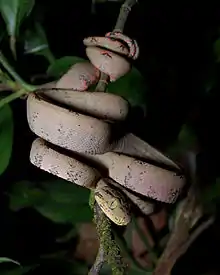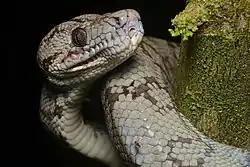Corallus hortulana
Corallus hortulana is a non-venomous boa species found in South America. No subspecies are currently recognized.[3]
| Corallus hortulana | |
|---|---|
 | |
| Juvenile in Ecuador | |
| Scientific classification | |
| Kingdom: | Animalia |
| Phylum: | Chordata |
| Class: | Reptilia |
| Order: | Squamata |
| Suborder: | Serpentes |
| Family: | Boidae |
| Genus: | Corallus |
| Species: | C. hortulana |
| Binomial name | |
| Corallus hortulana | |
| Synonyms | |
| |
Description
Adults grow to an average of 5 and 6.5 feet (1.5–2 m) in length.[5] This species exhibits an immense variety of colors and patterns. The basic color can be anywhere from black, brown, or gray, to any shade of red, orange, yellow, or many colors in between.[6] Some are totally patternless, while others may be speckled, banded, or saddled with rhomboid or chevron shapes. Some reds will have yellow patterns, some yellows red or orange patterns. Generally, there are two color 'phases' that are genetically inherited, but are not ontogenic as with the emerald tree boa,C. caninus and the green tree python, Morelia viridis. The 'garden phase' refers to boas with drab coloration, mostly brown or olive, with varied patterning, while the 'colored phase' refers to animals with combinations of red, orange, and yellow coloring.
 adult in Peru
adult in Peru juvenile in Peru
juvenile in Peru
Geographic range
Found in South America in southern Colombia east of the Andes, southern Venezuela, Guyana, Suriname, French Guiana, Amazonian Brazil, Costa Rica Ecuador, Peru, and Bolivia. The type locality given is "America."[2]
Typically found below 300 m elevation.
Behavior
These animals are notorious for being very aggressive, although the extent of such varies. These animals also have very long needle-like teeth, which makes their bite quite painful. However, these snakes tend to give some warning of being inclined to bite, and will usually give fairly gentle bites (which can still draw blood) unless they are given reason to give a full strike.
An aggravated tree boa might whip its tail and release a foul smelling liquid, commonly referred to as "musk", that is difficult to remove. This is a similar tactic seen in different animals from skunks to insects.
The aggression may be exaggerated by handling at night. Amazon tree boas are nighttime hunters, and may exhibit food aggression at this time. Warm, moving hands can be mistaken for prey, possibly eliciting a bite. It is uncommon for a constrictor to strike and constrict the handler, as they would a food item, unless the snake is very agitated.
These snakes are quite slim and don't have the mass of some of their other constrictor cousins such as the terrestrial python, boa and rat/corn snake species. Prospective owners however should be advised that while the snake is quite lightweight and slender in comparison to some other species, it is still an undomesticated animal capable of causing injury. It has the ability to resist being moved by anchoring itself to the local surroundings, and, if agitated, striking to defend itself. Male snakes also have pelvic spurs (vestigial leg bones) on the ventral aspect of the body adjacent to the vent and may use these for self defense. The spurs, incidentally, are also used to assist in mating.
A good tip to protect oneself from bites is to wear thick gloves over the hands; this can shield the heat of the hands and therefore the snake may be less likely to strike without a heat-emitting target.
References
- NatureServe (2013). "Corallus hortulanus". IUCN Red List of Threatened Species. 2013. Retrieved 15 December 2014.CS1 maint: ref=harv (link)
- McDiarmid RW, Campbell JA, Touré T. 1999. Snake Species of the World: A Taxonomic and Geographic Reference, vol. 1. Herpetologists' League. 511 pp. ISBN 1-893777-00-6 (series). ISBN 1-893777-01-4 (volume).
- "Corallus hortulanus". Integrated Taxonomic Information System. Retrieved 14 July 2008.
- Mehrtens JM. 1987. Living Snakes of the World in Color. New York: Sterling Publishers. 480 pp. ISBN 0-8069-6460-X.
- Burnie D, Wilson DE. 2001. Animal. Dorling Kindersley. 624 pp. ISBN 0-7894-7764-5.
- "Amazon Tree Boa". Reptile Range. Retrieved 31 December 2020.
Further reading
- Mattison C. 1999. Snake. DK Publishing. ISBN 0-7894-4660-X.
External links
| Wikimedia Commons has media related to Corallus hortulana. |
- Corallus hortulanus at the Reptarium.cz Reptile Database. Accessed 14 July 2008.
